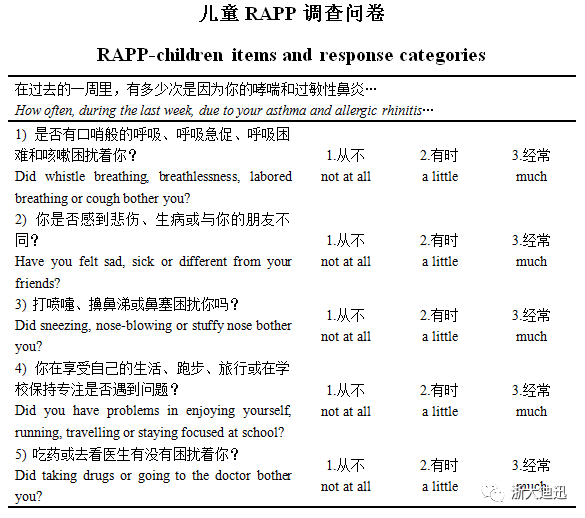Clin Exp Allergy: 儿童RAPP问卷—评估哮喘和鼻炎患者生活质量的新工具
发布日期:2020-07-17
原标题:儿童RAPP问卷—评估哮喘和鼻炎患者生活质量的新工具
方法:儿童RAPP问卷是通过将儿童鼻炎量表分为五个独特的项目得出的。在基线(T0)和30天(T1)之后,对150例合并性哮喘(主要是间歇性或轻度持续性)和鼻炎的儿童(6-11岁)进行了以下研究:儿童RAPP问卷,儿童合并性哮喘和鼻炎问卷,儿童哮喘生活质量问卷(PAQLQ,年龄>6岁),儿童鼻—结膜炎生活质量问卷(PRQLQ),儿童哮喘控制测试(CACT)、KiddyKindl®(6岁)或KidKindl®(年龄>6岁)和鼻症状视觉模拟量表(VAS)。最后一次就诊时,实施全球变化评级(GRC)量表。研究已在中央注册系统ClinicalTrials.gov(ID:NCT03276416)上注册。
结果:儿童RAPP调查问卷能很好地再现哮喘儿童评分(相关系数在0.91~0.95之间)。儿童RAPP调查问卷在临床稳定(GRC=0)的情况下表现出充分的收敛有效性(与PAQLQ、PRQLQ、CACT、KiddyKindl/KidKindl和VAS的绝对斯皮尔曼秩相关系数>0.5)、内部一致性(克朗巴哈系数>0.70)、)、重复性(组内相关系数在0.61和0.8之间)、判别效度(对哮喘控制状态和鼻炎严重程度的敏感性)和对症状改善的敏感性(GRC>1)。最小重要差异(MID)为-20。地板效应和天花板效应的影响很小。儿童RAPP调查问卷在较年幼的儿童(6-8岁)中也表现出良好的可用性。
结论:儿童RAPP调查问卷是一份有效的五项问卷,用于评估6-11岁伴有哮喘和鼻炎的儿童的生活质量。虽然中重度哮喘患者需要进一步的研究,但该工具在临床试验和常规医疗实践中对改善儿童呼吸道过敏的管理是有用的。

延伸阅读
Clinical & Experimental Allergy
DOI: 10.1111/CEA.13599
Abstract:
Background: RhinAsthma Patient Perspective (RAPP) is a short, validated questionnaire for assessing health-related quality of life (HRQoL) in adult patients with comorbid asthma and rhinitis, while a paediatric version is still not available.
Methods: RAPP-children was derived by combining RhinAsthma-children subscales into five unique items. At baseline (T0) and after 30 days (T1), 150 children (6-11 years) with comorbid asthma (predominantly intermittent or mild persistent) and rhinitis were given the following: RAPP-children, RhinAsthma-children, Paediatric Asthma Quality of Life Questionnaire (PAQLQ, age >6 years), Paediatric Rhinoconjunctivitis Quality of Life Questionnaire (PRQLQ), Childhood Asthma Control Test (CACT), KiddyKindl® (age 6 years) or KidKindl® (age >6 years), and a Visual Analogue Scale for nasal symptoms (VAS). At the final visit, a Global Rating of Change (GRC) scale was administered. The approved study was registered on the central registration system ClinicalTrials.gov (ID: NCT03276416).
Results: RAPP-children fairly reproduced RhinAsthma-children scores (concordance correlation coefficients between 0.91 and 0.95). RAPP-children showed adequate convergent validity (absolute Spearman’s rho larger than 0.5 with PAQLQ, PRQLQ, CACT, KiddyKindl/KidKindl, and VAS), internal consistency (Cronbach’s alpha >0.70), repeatability (intra-cluster correlation coefficient between 0.61 and 0.8) in the presence of clinical stability (GRC=0), discriminant validity (sensitivity to asthma control status and rhinitis severity), and sensitivity to symptom improvements (GRC>1). The minimal important difference (MID) was -20. Floor and ceiling effects were minimal. RAPP-children showed fair usability also in younger children (6-8 years).
Conclusion: RAPP-children is a valid, five-item questionnaire for assessing HRQoL in children aged 6 to 11 years with concomitant asthma and rhinitis. Although further investigation is required in moderate and severe asthmatics, this tool can be useful in clinical trials and in routine medical practice for improving the management of respiratory allergy in children.
First Author:
Salvatore Fasola
Correspondence:
Salvatore Fasola, Institute for Biomedical Research and Innovation, National Research Council, Palermo, Italy, Via Ugo La Malfa 153, 90146 Palermo, Italy.
All Authors:
Salvatore Fasolaa, Laura Montalbanoa, Giuliana Ferranteb, Giovanna Cilluffoa, Velia Maliziaa, Ilaria Baiardinic, Fulvio Braidod, Giovanni Viegia, Stefania La Gruttaa.


——浙大迪迅 译
背景:RhinAsthma Patient Perspective(RAPP)是经过验证的简短问卷,用于评估合并性哮喘和鼻炎的成年患者的健康相关生活质量(HRQoL),但尚无儿科版本。 方法:儿童RAPP问卷是通过将儿童鼻炎量表分为五个独特的项目得出的。在基线(T0)和30天(T1)之后,对150例合并性哮喘(主要是间歇性或轻度持续性)和鼻炎的儿童(6-11岁)进行了以下研究:儿童RAPP问卷,儿童合并性哮喘和鼻炎问卷,儿童哮喘生活质量问卷(PAQLQ,年龄>6岁),儿童鼻—结膜炎生活质量问卷(PRQLQ),儿童哮喘控制测试(CACT)、KiddyKindl®(6岁)或KidKindl®(年龄>6岁)和鼻症状视觉模拟量表(VAS)。最后一次就诊时,实施全球变化评级(GRC)量表。研究已在中央注册系统ClinicalTrials.gov(ID:NCT03276416)上注册。
结果:儿童RAPP调查问卷能很好地再现哮喘儿童评分(相关系数在0.91~0.95之间)。儿童RAPP调查问卷在临床稳定(GRC=0)的情况下表现出充分的收敛有效性(与PAQLQ、PRQLQ、CACT、KiddyKindl/KidKindl和VAS的绝对斯皮尔曼秩相关系数>0.5)、内部一致性(克朗巴哈系数>0.70)、)、重复性(组内相关系数在0.61和0.8之间)、判别效度(对哮喘控制状态和鼻炎严重程度的敏感性)和对症状改善的敏感性(GRC>1)。最小重要差异(MID)为-20。地板效应和天花板效应的影响很小。儿童RAPP调查问卷在较年幼的儿童(6-8岁)中也表现出良好的可用性。
结论:儿童RAPP调查问卷是一份有效的五项问卷,用于评估6-11岁伴有哮喘和鼻炎的儿童的生活质量。虽然中重度哮喘患者需要进一步的研究,但该工具在临床试验和常规医疗实践中对改善儿童呼吸道过敏的管理是有用的。

延伸阅读
Clinical & Experimental Allergy
[IF:5.158]
RAPP-children: a new tool for assessing quality of life in patients with asthma and rhinitisDOI: 10.1111/CEA.13599
Abstract:
Background: RhinAsthma Patient Perspective (RAPP) is a short, validated questionnaire for assessing health-related quality of life (HRQoL) in adult patients with comorbid asthma and rhinitis, while a paediatric version is still not available.
Methods: RAPP-children was derived by combining RhinAsthma-children subscales into five unique items. At baseline (T0) and after 30 days (T1), 150 children (6-11 years) with comorbid asthma (predominantly intermittent or mild persistent) and rhinitis were given the following: RAPP-children, RhinAsthma-children, Paediatric Asthma Quality of Life Questionnaire (PAQLQ, age >6 years), Paediatric Rhinoconjunctivitis Quality of Life Questionnaire (PRQLQ), Childhood Asthma Control Test (CACT), KiddyKindl® (age 6 years) or KidKindl® (age >6 years), and a Visual Analogue Scale for nasal symptoms (VAS). At the final visit, a Global Rating of Change (GRC) scale was administered. The approved study was registered on the central registration system ClinicalTrials.gov (ID: NCT03276416).
Results: RAPP-children fairly reproduced RhinAsthma-children scores (concordance correlation coefficients between 0.91 and 0.95). RAPP-children showed adequate convergent validity (absolute Spearman’s rho larger than 0.5 with PAQLQ, PRQLQ, CACT, KiddyKindl/KidKindl, and VAS), internal consistency (Cronbach’s alpha >0.70), repeatability (intra-cluster correlation coefficient between 0.61 and 0.8) in the presence of clinical stability (GRC=0), discriminant validity (sensitivity to asthma control status and rhinitis severity), and sensitivity to symptom improvements (GRC>1). The minimal important difference (MID) was -20. Floor and ceiling effects were minimal. RAPP-children showed fair usability also in younger children (6-8 years).
Conclusion: RAPP-children is a valid, five-item questionnaire for assessing HRQoL in children aged 6 to 11 years with concomitant asthma and rhinitis. Although further investigation is required in moderate and severe asthmatics, this tool can be useful in clinical trials and in routine medical practice for improving the management of respiratory allergy in children.
First Author:
Salvatore Fasola
Correspondence:
Salvatore Fasola, Institute for Biomedical Research and Innovation, National Research Council, Palermo, Italy, Via Ugo La Malfa 153, 90146 Palermo, Italy.
All Authors:
Salvatore Fasolaa, Laura Montalbanoa, Giuliana Ferranteb, Giovanna Cilluffoa, Velia Maliziaa, Ilaria Baiardinic, Fulvio Braidod, Giovanni Viegia, Stefania La Gruttaa.
2020-07-06 Article
创建过敏性疾病的科研、科普知识交流平台,为过敏患者提供专业诊断、治疗、预防的共享平台。

 杭州浙大迪迅生物基因工程有限公司
杭州浙大迪迅生物基因工程有限公司

